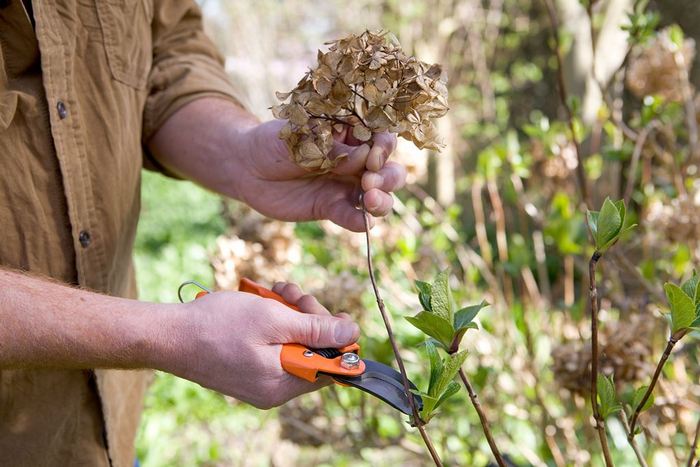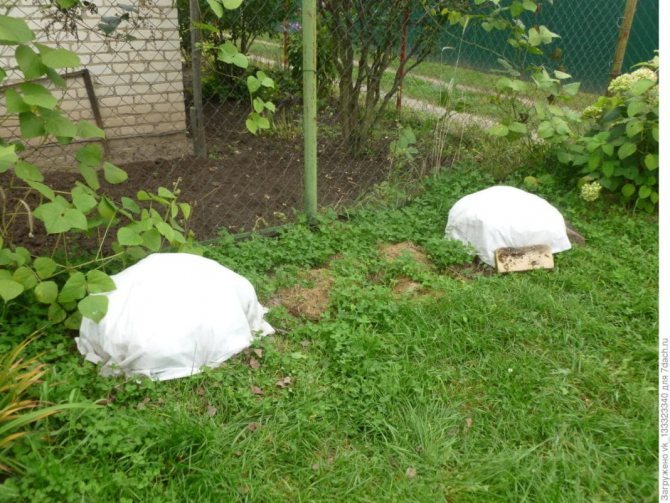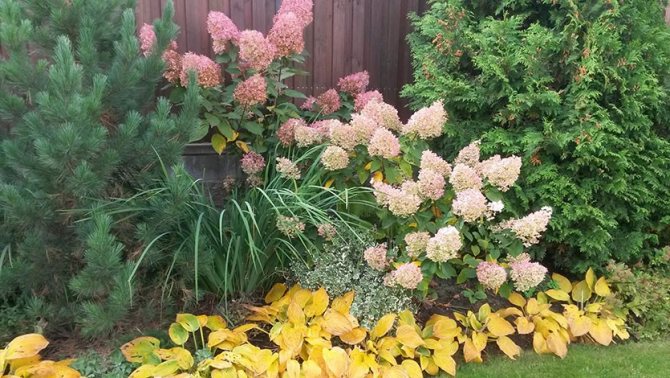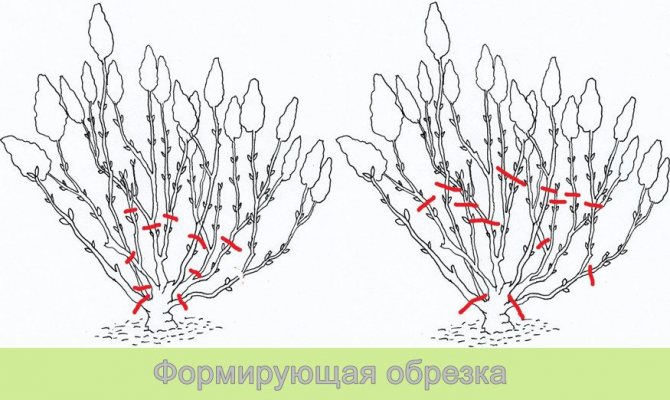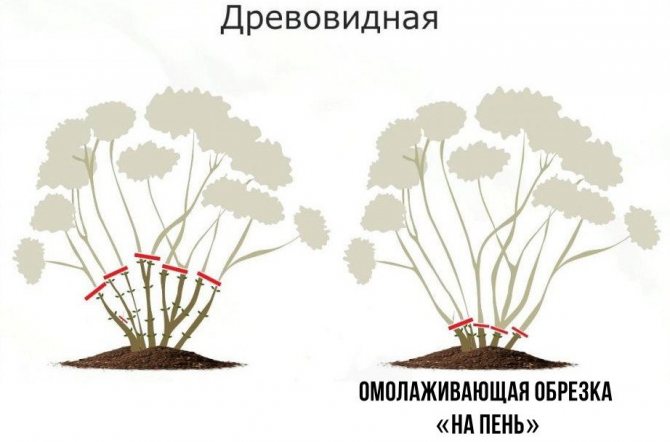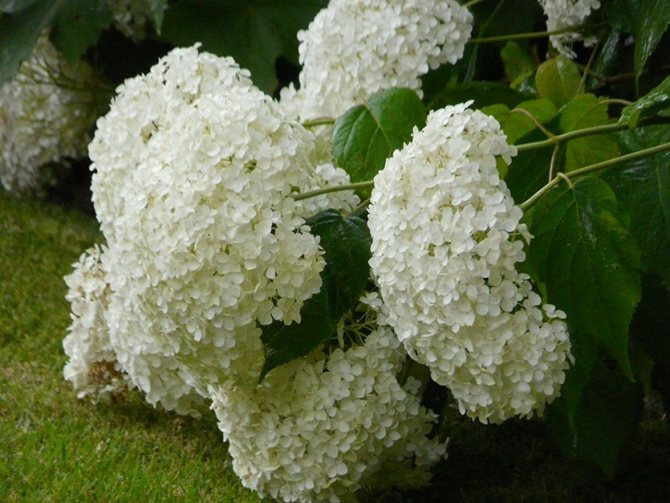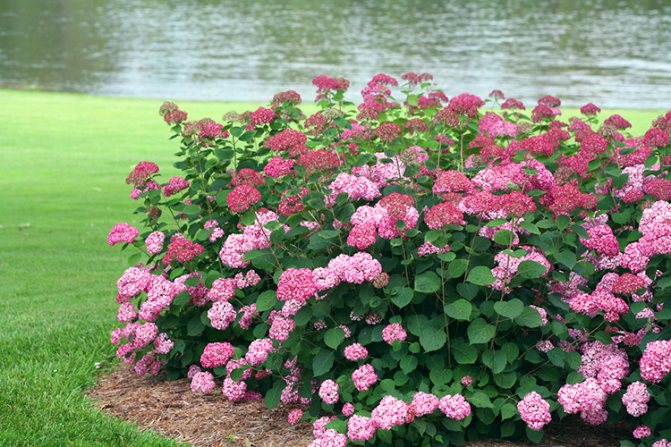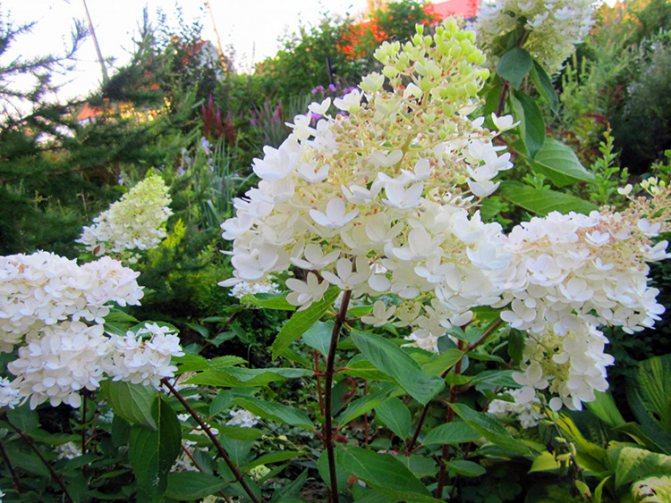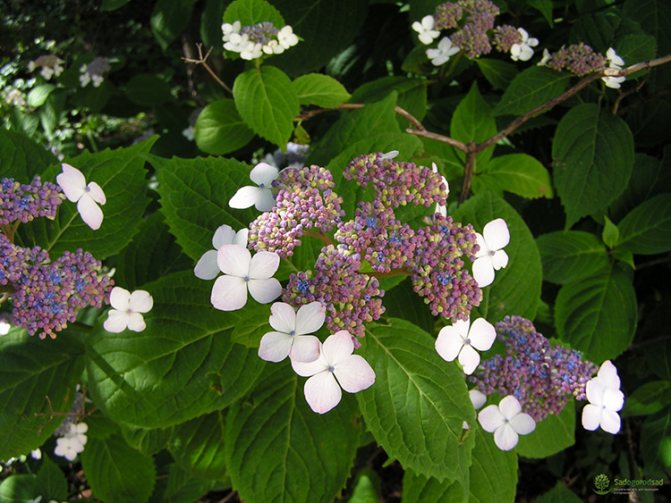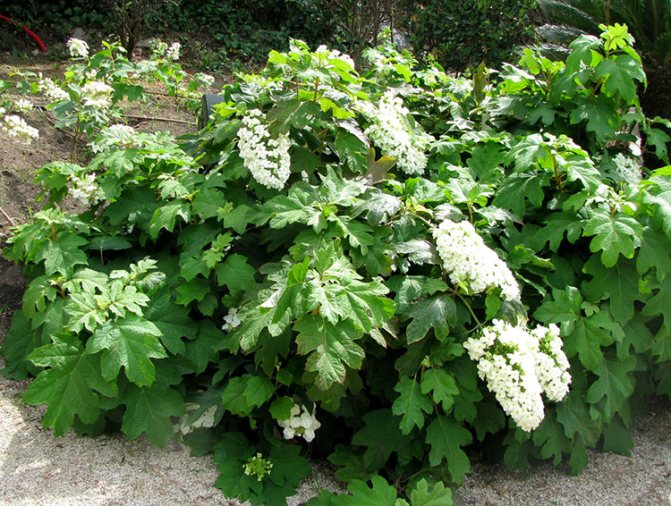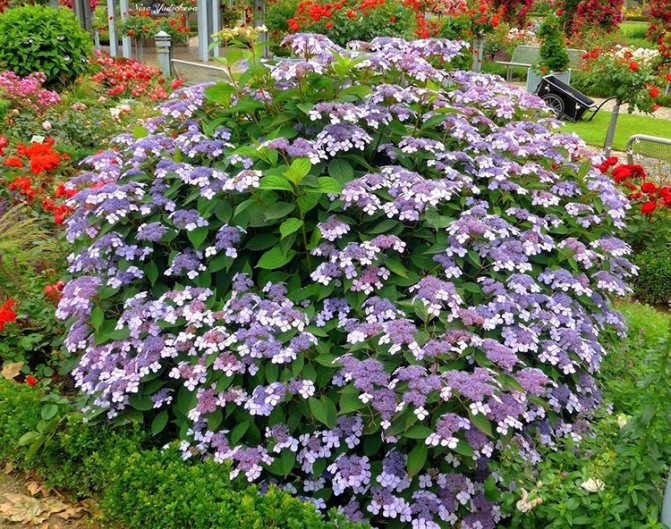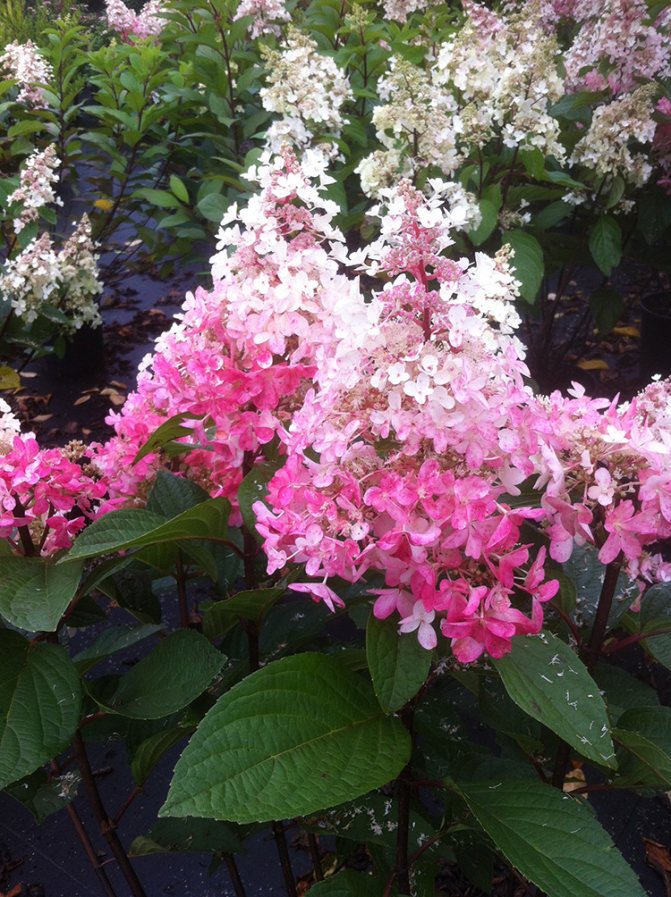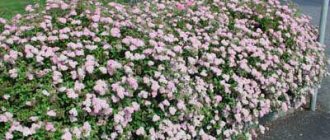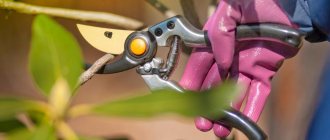During the flowering period, the hydrangea, like a rose, becomes the queen of the garden. But you should not think that after it is over, you can forget about it. On the contrary, autumn is the time when you must take care of the plant as much as possible so that it starts blooming with renewed vigor next year. We will tell you how to care for this shrub in the fall and how to properly prepare it for the frosty winter.

Timing of pruning
The exact timing of work with plants depends on the climate of the area, the established weather. Many gardeners agree on the timing of planting and pruning hydrangeas in the fall with the recommendations of the lunar calendar.
Auspicious days according to the lunar calendar
In the fall of 2020, the shrub will more easily tolerate pruning on the following dates:
- September - from 14 to 19, 23 and 24, from 26 to 30;
- October - from 1 to 3, 8, from 10 to 15, from 20 to 22.
In the spring of 2020, hydrangea can be pruned on these days:
- March - 7, 11, 15, 16;
- April - 8, 11, 18.
Depending on the climate of the region
The bushes of young hydrangea are not cut in the fall for a couple of years after planting, allowing the plants to grow stronger. Shoots damaged by snow or frost are removed only in early spring.
An adult perennial begins to cut off after leaf fall, when the branches are exposed from the foliage and the sap flow in the shoots slows down.
Timing of pruning hydrangea in autumn by region:
In the Central lane and the Moscow region, the period from mid-September to early October is traditionally considered to be deciduous. At this time, until the frost hit, work is being done to trim the perennial bushes.
In the Leningrad region, hydrangea is cut in September.
In the Urals and Siberia, pruning terms are compressed due to the short autumn and the early arrival of cold weather. The plant is cut in early September.
In these regions, the hydrangea is not cut too short (it is enough to shorten the shoots by a third), otherwise, in a short summer, the shoots will not have time to lay buds for flowering.
In the south of our country, pruning is carried out in October.
In Ukraine and Belarus, the climate is mild, autumn is warm. Hydrangea is pruned in October.
Listen to the article
Hydrangea (lat.Hydrangea) - flowering plants of the Hortensia family, of which, according to various sources, there are from 30 to 80 species in nature. Among them are shrubs and small trees that grow mostly in East and South Asia, China, Japan, the Far East, and the Americas. The plant was named in honor of Princess Hortense, whom no one remembers for a long time, later, when botanists were systematizing plants, the hydrangea received the Greek name Hydrangea, which translates as "a vessel with water" - the shape of the seed pods of the plant resembles a jug, and the plant itself is very loves water.
The Japanese call the hydrangea "adzisai", which means "flower - purple sun". It was from Japan that hydrangea was brought to Europe in 1820, and was grown at first because of its low winter hardiness only as a houseplant, but breeders were so carried away by the cultivation of hydrangea that by the middle of the 20th century more than 100 garden varieties were created. In our latitudes, garden hydrangea is represented quite widely - twelve popular species.
Hydrangea pruning rules
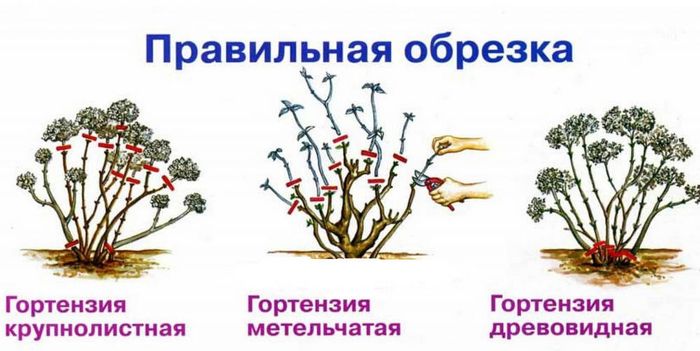

Shrub trimming is carried out in spring and autumn.
- The nature of spring work is to remove frost-damaged shoots, twigs broken by snow. This is called sanitary pruning. It is carried out immediately after the snow melts, before the leaves bloom.
- Autumn haircut consists in crown formation and is aimed at stimulating the plant to create a large number of flower buds. The work is carried out on days when the air temperature during the day has not yet dropped below +7 degrees.
The nature of pruning hydrangeas in the fall differs depending on the variety. Shrub varieties are divided into groups:
- hydrangea that forms flowers on the shoots of the last year (large-leaved hydrangea);
- a plant blooming on annual twigs (paniculate, arboreal, Vanilla Freise).
A common action for all hydrangeas will be to remove damaged shoots and branches that thicken the crown. Old, obsolete branches are cut down at the root.
A useful video about the differences in the types and methods of cropping from the Garden World channel:
Pruning hydrangea paniculata in autumn
After removing all unnecessary branches, they begin to form a bush.
- To get a powerful growth of shoots and large inflorescences for the next year, all lateral branches of the plant are cut off, leaving 2 buds.
- 2-3 strong shoots are left on the bush for rejuvenation. Branches older than 4 years are removed.
Pruning hydrangeas in a tree-like fall, similar to trimming the paniculate variety. Both plants form flowers on young shoots.
Video: pruning panicle hydrangea depending on the variety
Large-leaved hydrangea
The shrub is cut minimally in autumn, removing only faded inflorescences and weak branches thickening the crown.
The rejuvenation of the shrub is carried out every 3 years, shortening the old branches by 40 cm.
Video: pruning a tree hydrangea
Pruning hydrangeas in the fall for beginners
It can be difficult for a novice gardener to immediately understand the intricacies of pruning a shrub. For convenience, below is a step-by-step scheme for pruning hydrangea paniculate and tree-like (the gardener remembers that only the inflorescences are removed from the large-leaved one).
Pruning is carried out when the leaves from the plant have already flown. Looking at the bare branches makes it easier to identify excess shoots.
They begin to form a hydrangea from the age of 4.
Use a sharp pruner or garden saw to remove:
- old branches (over 4 years old) under the root;
- weak and thin shoots, thickening the crown.


Further, on a panicle hydrangea, 5-6 strong shoots are chosen, arranged in a fan (at approximately equal distance from each other). They are shortened to 2-4 buds from the base of the bush. The remaining branches are removed without leaving hemp.
Garden hydrangea, if the bush is not thickened, you do not need to cut.
Features of autumn pruning of a plant, depending on the species
Pruning hydrangeas should be done just before its shelter for the winter. This happens with the onset of persistent frosts in November. The procedure must be performed using sharp garden shears or pruning shears, the blade of which is pre-treated with a solution of potassium permanganate or medical alcohol to exclude infection of the shrub.
Features of pruning hydrangea, depending on its type:
- Paniculate and large-leaved... This shrub only needs sanitary pruning for the winter. It consists in cutting off dry, diseased, damaged, thin, weakened and fattening shoots. Additionally, you need to cut off the former inflorescences. Cut off any shoots that have not bloomed this year.
- Tree-like... In addition to sanitary pruning, this type of hydrangea needs to be made short before winter. This means that you first need to remove all of the above shoots and inflorescences, and then proceed to shortening healthy ones. To do this, each branch is shortened so that only 4 buds remain on each of them.So, shoots can be shortened by 60-80% of their original length.
Important! You can not shorten the shoots of large-leaved and paniculate shrub varieties. This can lead to the fact that the next year the bush will not bloom. This method of pruning is used exclusively for tree hydrangea.
You need to cut the hydrangea "for the kidney". This means that the cut must be oblique (at an angle of 45 degrees). Moreover, the upper part of it should begin immediately above the kidney, and the lower one - on the opposite side, level below. If you do not adhere to these rules, then the shoots of the bush may begin to dry out.
After pruning, the hydrangea must be treated with a 0.2% Fundazol solution or another drug that prevents the growth of pathogenic microflora. For this, you can use a 10% solution of copper sulfate. Preventive treatment of the bush before sheltering for the winter helps to keep the bush healthy until spring.
How to feed hydrangea in the fall after pruning
In autumn, the main task of the gardener in caring for a perennial is to prepare the plant for winter. Proper feeding plays an important role in the successful wintering of hydrangeas.
Phosphate-potassium fertilizers are used, which contribute to better maturation of wood and root system.
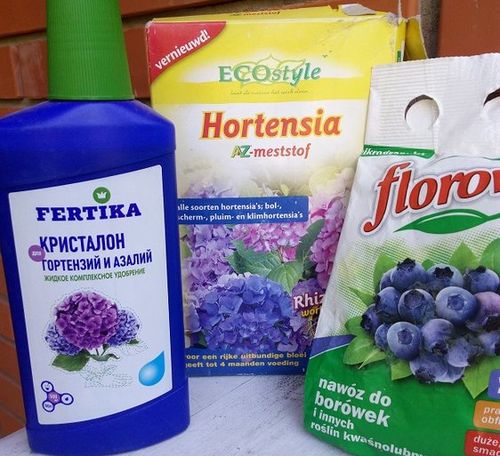

It is convenient for a novice gardener to purchase ready-made complexes of mineral fertilizers, especially for the autumn feeding of hydrangeas. For example:
- Fertika (in liquid form);
- Pocon (fertilizer granules are simply scattered over the soil surface, they gradually dissolve, nourishing the plant).
Autumn transplant
It may be interesting How to feed an orchid for long flowering Growing eggplants in a polycarbonate greenhouse Indoor fern: features of growing and caring for a plant at home
A hydrangea transplant is necessary for old plants when leaving in the fall and preparing for winter. But most species do not tolerate this procedure well.
For hydrangeas, planting pits are prepared in a sunny place. The depth and width of the recess should be greater than the transplanted bush. Peat, sand, complex fertilizers, except for nitrogen fertilizers, are added to it.
4-5-year-old plants are carefully dug out from the same place, placing a shovel 20 cm from the edge of the crown of the bush so as not to damage the roots. After planting, the hydrangea is buried, the soil is tamped, and watered abundantly.
In a new place, the color of the hydrangea may change, since the composition of the soil may be different.
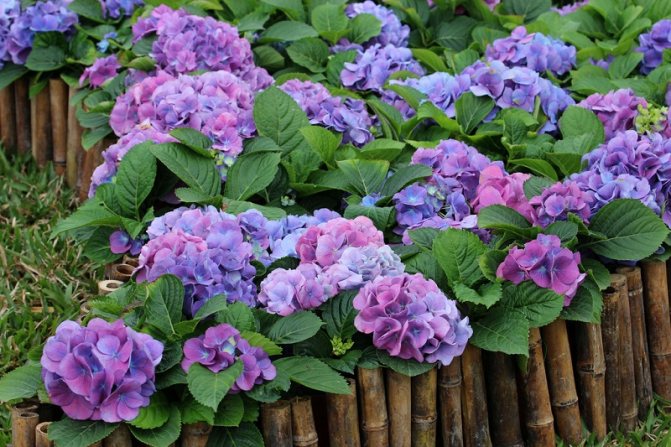

Shelter hydrangea in autumn
All perennial species need shelter for the winter. It is possible to avoid works on plant insulation only in the south, where winter temperatures do not drop below -20 degrees.
Young seedlings up to 3 years of age are wrapped most thoroughly. They are piled up with humus, peat, pine needles or wood chips by 25-30 cm. Strong arcs are installed above the plant and lutrasil or other insulating material is put on. In winter, additional snow is thrown on the bushes.
An adult hydrangea is mulched, with a layer of 5-8 cm. Large-leaved varieties, which are not cut short, are bent and fixed at the surface of the earth. This makes it easier to cover the plant with snow. In regions with harsh winters, the bushes are insulated with spruce branches, agrotextile or burlap.


In the spring, the shelter is removed after the snow melts. Spring frosts will not damage the hydrangea, and a delay in removing the cover can lead to rotting of the plant.
Above, we described the rules and features for pruning hydrangeas in the fall for beginners. Use pruning that suits your type of shrub and let it delight you with bright colors for a long time!
Share link:
Not many people know if pruning hydrangeas is always required in the fall, but for beginners and beginners this is an important point. After all, much depends not only on whether a large-leaved, paniculate or tree-like beauty grows in the garden, but also on the development of the plant. In order not to be mistaken and to carry out the work on time, be sure to familiarize yourself with the technology and the intricacies of the process ...
How to care for hydrangeas in autumn: secrets of care and preparation for cold weather
The composition of the care of hydrangeas in the fall includes the following:
- Eradicating autumn spraying (treatment) from diseases and pests (as an option, you can use a 3% solution of Bordeaux liquid).
- Transfer (but only paniculate or tree-like varieties, it is better to replant large-leaved in spring).
By the way! You can plant new hydrangea seedlings in the fall.
- Reproduction (by dividing the bush or digging in layers, but grafting is carried out only in summer).
By the way! You can transplant a shrub just by propagating it by dividing the bush.
- Top dressing and watering (more on this later).
- Pruning.
- Shelter for the winter.
Moreover especially important to properly prepare the hydrangea for winter, namely to hold autumn pruning and shelter for the winter.
Autumn feeding of hydrangea and its watering regime
When the hydrangeas finish their flowering, and their buds begin to dry out gradually, it's time for autumn feeding, which should help the shrub to hibernate in a strong state, successfully laying vegetative and flower buds for future growth and flowering in the new year.
In the fall, it is necessary to apply potash-phosphorus fertilizers to the soil, hydrangeas are no exception. During this period, it will be good to feed them with potassium sulfate - as a potassium fertilizer, superphosphate - as a phosphorus fertilizer. Or you can buy ready-made autumn fertilizer.
Remember! No nitrogen fertilizers in the autumn, and no ash as a potassium supplement, because it alkalizes the soil, while hydrangeas, on the contrary, need soil-acidifying fertilizing.
But watering in the fall is practically stopped (especially if the weather is cloudy and / or rainy), although, as you know, hydrangea loves moisture very much, so it is very important to water it regularly during hot periods of the year during abundant flowering.
Highlights of the process
Pruning hydrangeas in the fall is done according to the type of flowering. Shrub species are divided into two groups:


- large-leaved blooming on last year's shoots, it is serrate, oak-leaved, Japanese Keriya, Macrophila, Sargent, Deytsia, etc.
- hydrangea that gives color on annual growths - paniculate, tree-like, these are Anabel Pink (pink) and Anabel Strong (white), Grandiflora, Inkredibol, Vanilla Freise (Vanilla Freise), Unic, Phantom and others
Based on these indicators, they decide how to prune the hydrangea for the winter. The shrub is cleaned in the spring and autumn, but autumn cutting is preferable, since in the spring juices begin to circulate in the bush, when the branches are amputated, the plant cries profusely, which can lead to the death of the bush.
Too old plants are cut on a stump - all branches are removed, small stumps 8-10 cm high from the roots are left. But, if the plant is too large, the procedure must be extended for 2-3 years, otherwise the roots will not be able to receive all the substances necessary for life and will die in the winter.
Hydrangea flower - description
Most of the species of hydrangea are shrubs with a height of 1 m to 3 m, there are among the hydrangeas and trees, and lianas climbing tree trunks to a height of 30 m.Among the representatives of the genus there are evergreen species, and there are deciduous ones, but in our latitudes they are grown it is the latter, blooming from spring to late autumn. Two types of flowers are collected in globular inflorescences at the ends of the stems - sterile at the edges and fertile in the middle of the inflorescence. The flowers are most often white, but a species such as large-leaved hydrangea is represented by varieties with pink, blue, lilac and red flowers, and determines the color of the specimen by the acidity of the soil. For example, hydrangeas with blue flowers grow in acidic soil, lilac and pink flowers in alkaline soil, and pale beige flowers in neutral soil.The hydrangea fruit is a multiparticle box with seeds.
- How to care for heychera in the garden
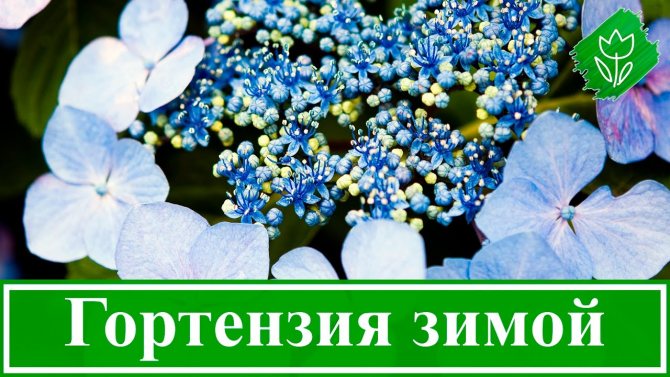

In addition to large-leaved, tree hydrangea grows well in our climate, known for its winter hardiness and ability to recover well after severe frosts. Panicle hydrangea, known for its durability, also winters well - it can grow in one place for up to 60 years.
In addition to these three most popular species, such species as serrata hydrangea, serrata hydrangea, climbing hydrangea, radiant hydrangea, Sargent hydrangea, petiolate hydrangea, oak-leaved hydrangea and others are known in floriculture.
Pruning large-leaved hydrangea
A feature of the shrub is the growth of flowering shoots on the upper last year's branches. That is why it is so important to preserve them by covering the hydrangea from frost for the winter - the main stripping is done by removing the lower branches, and the upper ones are removed in case of frostbite only in spring. The plant often produces zero shoots, but flower buds rarely form on the lower branches.
When pruning for flowering, they try not to overdo it, otherwise you can not wait for the buds in the next season. Ideally, panicles are cut in the summer after flowering, so that the branches have time to give young shoots before the onset of cold weather.
When the bush has bloomed profusely, you can thin out young branches growing inward to make room for new ones to grow. To rejuvenate hydrangeas, remove a quarter of the old shoots up to 30-40 cm every 3 years. Before sheltering for the winter, weak and old branches are cut. After the leaves are removed, the bush is wrapped up. But, you need to know how to cover the hydrangea for the winter so that the plant does not die and pleases with lush flowering next year. After all, flowering strongly depends on how the flower has endured frost.
You should also focus on the plant variety and climatic conditions. With a long, warm summer and good shoot-forming ability of the bush, you can clean the plant more thoroughly. In this way, hydrangeas are pruned in the fall in the Moscow region, in the Kuban, and in the southern regions. In Siberia, in the Urals, in the Leningrad region, where the summers are short and cold, hydrangea pruning is done superficially, since the annual branches simply do not have time to bloom.
Mistakes of novice florists
Common mistakes:
- Application of nitrogen fertilizers... They will not be absorbed by the plant, and in the spring they will be washed out of the ground with melt water.
- Pruning the shoots of paniculate and large-leaved hydrangea... By cutting off the tops of the shoots, you remove all flower buds. Such a bush will not bloom.
- Lack of preventive treatment... Mold develops under the winter shelter. But it can be avoided by pre-processing the bush.
By properly caring for hydrangeas in the fall, you stimulate the formation of flower buds. And this is an important condition for the lush flowering of the shrub. Do not make mistakes in care so that the hydrangea becomes the queen of your garden from year to year.
Pruning panicle hydrangea
In order to properly cut the panicle hydrangea in the fall, you should not be zealous, therefore, the formative pruning is done as follows - skeletal branches (shoots from one point) are not touched, cutting only those that grow inside the bush, dried panicles are also cut off - young branches are too fragile and can break under the weight of the snow.
In autumn, in paniculate hydrangea, it is imperative to cut off the buds that have already faded and part of the shoot on which they grew, since flowering occurs on annual branches. Leave a couple of buds (3-4) and do not cut off the shoot completely so that the plant looks beautiful and lush next spring. In the case when the bush needs rejuvenation, remove several shoots growing from one point, leaving 1-2 ones growing outward.
Preliminary activities
Before covering the hydrangea, it is necessary to trim the leaves. After that, the branches need to be collected in bunches and tied.This is necessary so that the shoots do not break from bending. Further, the associated shoots must be tilted and pressed against the soil, and then fixed with metal clamps. Curved welding electrodes can be used instead. If the shoot is lignified and resists bending, then the procedure is carried out gradually.
Did you know? Hydrangea absorbs aluminum from the soil, which is why some species are able to acquire a bluish tint of flowers.
Pruning
Timely pruning of the plant is necessary in order to ensure full flowering in the future.... It is performed before the onset of frost. September is considered the most suitable time for Siberia. Having cut off the buds and leaves that have dried up in autumn, you can not worry that they will rot under the winter shelter. During the procedure, you should leave the flower buds, which cover the special leaves.
When pruning a plant, you need to adhere to the following rules:
- remove branches only from healthy specimens that are already 4 years old at the time of the care procedure in order to avoid decay;
- from old shrubs, branches can be removed almost completely in order to get new young shoots in their place;
- rejuvenation is carried out no more than once every 3-4 years.


Top dressing
Top dressing is done twice a year. PThe first time fertilization is applied in the spring, the second - during the appearance of inflorescences. For spring fertilization, a mixture of potassium, superphosphate and urea in equal proportions is best suited. One shrub should have about 120 g of fertilizer. During the flowering period, feeding is carried out using superphosphate and potassium in a 2: 1 ratio.
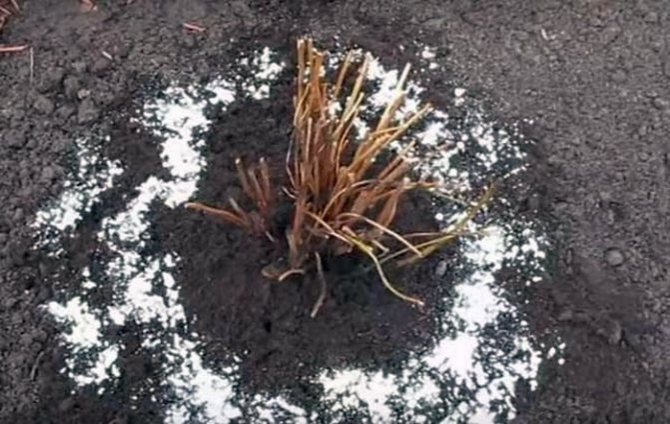

Prevention of pests and diseases
A prerequisite for preparing hydrangea for wintering is its preventive treatment against pests and diseases. For this purpose, the shrubs and the soil around them are sprayed with 3% Bordeaux liquid or 1% copper sulfate solution. The procedure is carried out in autumn at a temperature of about + 7 ° C, when the leaves have already fallen off. This will help protect the shoots from pests and diseases that can attack the plant when it gets warm.


Pruning hydrangea tree
Do I need to prune my hydrangea for the winter? Of course yes! The caps of the inflorescences bend under the weight of the snow and can break branches, it is much easier to wrap a peeled bush, in the spring life begins to boil in the plant, and there is plenty of work on the garden plot.
Before wintering, the bush is pruned according to the following scheme: young seedlings do not touch for three to four years. Active cutting can lead to the death of the shrub, so only faded inflorescences can be removed in the first years.
Since the treelike hydrangea forms flowers on annual shoots, accordingly, when they have faded, they can be removed. This means that in the fall, after flowering, even after the first frosts, we cut off the faded buds so that 3-4 pairs of buds remain on this one-year shoot. If you are familiar with the structure of a tree hydrangea, then you will see that the buds grow on it in pairs (next to each other). Therefore, we cut off the upper faded part, and do not touch the rest, so that the bush remains lush and beautiful with us, the main thing is not to forget to cover it for the winter.
When there is a need to rejuvenate the bush, cut off all the shoots under the stump, leaving up to 10 cm.With strongly overgrown roots, the process is stretched for several years, leaving the shoots to feed the root system. By gradually removing the shoots, the tree hydrangea is completely rejuvenated for 3-4 years.
Memo for pruning hydrangeas in the fall for beginners
- Large-leaved (colored, garden) beauty is pruned mainly in the spring, but before the cold weather, flower caps and zero shoots are removed
- Treelike and panicle hydrangea are cleaned in the fall, before wrapping for the winter, the pruning scheme is as follows - each shoot of this year is cut into 2-4 buds if the branch is growing strongly, and by 1/3 if the shoot is weak
- In the early stages of growth, it is better not to touch the bush - wait 3-4 years of age
- Adult panicle hydrangea in the fall undergoes thinning pruning and removal of panicles, shorten the shoots, carry out sanitary cleaning
- Short pruning allows you to get a tall bush with lush flowering, but branches above 150 cm can break off in strong winds, a thin shoot does not withstand the weight of the panicle and bends to the ground, in addition, it is extremely difficult to wrap a tall bush for wintering
- Hydrangea petiolate (liana-shaped) does not need pruning. Before wintering, you just need to remove dry foliage, broken off shoots and faded inflorescences. Since the liana grows very slowly, in the first 3-4 years it is not cut at all, and then some lashes can be removed to provoke a more lush flowering
Pruning hydrangea in the fall has many advantages - it provides abundant flowering, prevents shoot breakage, and is less aggressive for the plant than spring cleaning. Do not forget to feed the bush, cover it and wait for a lush bloom in the next season!
Hydrangea looks extraordinarily impressive at the time of flowering. Today the plant has regained its former popularity and is actively used in landscape design. Hydrangea is called by many the queen of the garden. The shrub is used to create single and group compositions, serves as a hedge, decorates the entrance to a house or a gazebo. To maintain the magnificent shape of the hydrangea, pruning is necessary, which should be carried out according to certain rules.
Types of hydrangea growing in our climate
Hydrangea Bobo - the most popular, was bred by Belgian biologists. Its height reaches a maximum of 70 cm, which makes it especially popular, because in this case it is much easier to allocate a planting site on the garden plot. This variety belongs to the early representatives - the flowers begin to bloom and turn pink in May. The appearance of the bush is quite dense with a rich green color.
Hydrangea paniculata Vanilla Freise - the shrub reaches a height of one and a half meters, but this does not take away the well-deserved popularity of the plant. Experienced growers are in awe of the density of the pyramidal inflorescences. In addition, the inflorescences always acquire two colors - the top is painted with a white tint, and the bottom becomes pale pink. As a result, the appearance is more like an ice cream cone. This hydrangea has huge drooping inflorescences, at the beginning of flowering they are creamy white, then turn pink and turn dark red towards the end of flowering. The intensity of the color may vary from year to year and depends on weather conditions and soil. Blooms continuously from mid-summer to autumn. The declared height of the bush is 1.5 m, but we already have bushes higher than 2 meters. In the Moscow region, it hibernates without shelter.
Due to the fact that ‘Vanilla Freyz’ has drooping “weeping” inflorescences, it is good to form “fountains” bushes from it.
Hydrangea Weems Red is a tall shrub, at least one and a half meters high. The variety has gained popularity due to its color of flowers. In the process of flowering, the shade of the inflorescences changes from white to bright red, burgundy. In addition, this variety is frost-resistant, therefore it is suitable for planting in any region of Russia. True, in Siberia and the Far East, additional cover for the bushes will be required for the winter.
This is an unusually beautiful hydrangea and its name speaks for itself - Early Sensation. For me, this variety is one of my favorites.
‘Early Sensation’ / Bulk. One of its advantages is that it blooms almost a month earlier than others and blooms with delicate, delicate inflorescences right up to the first frost. Weightless and strikingly graceful flowers seem to soar in the air and it seems that the bush is covered with lace. Therefore, I boldly call her "Lacy Beauty". The shrub has an asymmetrical crown.Another advantage is that, unlike other panicle hydrangeas, in which flower caps become ugly by autumn and acquire “rusty” shades, ‘Earley Sense’ never looks untidy. She knows how to age with dignity.
There is a large selection of varieties on sale, each of which has its own external differences and some features. Hydrangeas in Russia are very common due to their unusual appearance, as well as their ability to complement any composition in landscape design. There are two ways to grow a hydrangea: seedlings. the authors give the same recommendations for the "classical" pruning of hydrangeas - this is to remove all dry and thin branches, and cut the remaining branches of the current year into two or three buds. Everything! And these recommendations do not even say what kind of panicle hydrangea they are pruning. No, in principle, there is nothing wrong with these recommendations, but the same approach to all hydrangeas confuses, and they are so different! But we probably don't want our hydrangeas to be the same, like wooden soldiers.
Want a tall one, want a low and wide one, on a trunk, a bush "bouquet", "fountain", "fan" or even a small "tree", a bush with "legs" or without them, etc. etc.
Of course, all these “bouquets”, “fountains”, “fans” are purely conventional names and are given in one image or another just to make it visually easier to understand what we are going to form.
Do I need to prune hydrangeas in the fall


Pruning hydrangeas in the fall is part of winterizing the plant. Representatives of the hydrangea family are very diverse, there are about 80 species in total. Each variety tolerates winter cold in its own way. Plant care also depends on the climate in which it is grown.
In the fall, pest control is carried out, transplantation as needed, shrub reproduction. Pruning is considered an important technique for influencing the flowering pattern of hydrangeas. What specific activities related to haircuts should be carried out on the eve of winter?
First of all, all dry inflorescences are removed. In winter, snow can accumulate on them - this will lead to the fact that thin branches break off under its weight. In addition, thinning and sanitary pruning will not interfere with the plant. In this case, it is necessary to take into account the features of a particular type of hydrangea.
You should be puzzled by this procedure after the onset of the first frost. Nothing bad will happen even if the snow has time to fall. The shoots will already have lost their leaves at this point, and it will be clearly visible which of the branches it is better to leave and which to remove.
If there is still foliage on the shrub, there is a risk that after pruning the plant will release young shoots from the lateral buds. This will weaken the bush before hibernation. Therefore, try to delay the pruning of the shoots as long as possible.
How to properly prepare hydrangeas for winter: shelter and mulching
Of course, maintenance activities such as pruning, preventive spraying, and fertilizing help the flower culture to prepare for the frost in the fall. However, there are specific measures aimed at preparing the plant for winter, these include mulching and shelter.
Shelter for the winter is the most important component of care, which helps protect the shrub from bad weather and frost. However, not all types of flower culture need shelter:
- Panicle hydrangea do not cover, they are distinguished by excellent winter hardiness.
- Tree hydrangea also do not need shelter, they tolerate frost well.
Important! Although paniculate and treelike species do not need shelter, they need to be mulched in the fall.
- Large-leaved hydrangeas (garden) must be covered without fail! It is not hardy, if its flower buds freeze and die, then next season you will not see flowering.
- Oak-leaved and serrated species also need shelter.
Important! If a seedling was planted in the fall, then it is recommended to cover it for the winter, regardless of whether it is a frost-resistant species or not. Young bushes need shelter in the first 2 years of life.
Mulching paniculate and tree hydrangea
As mentioned above, panicle and tree hydrangeas are a frost-resistant crop, so they do not need shelter. However, as preparation for winter, you need mulch the trunk circle in the fall. Mulch plays an important role - it protects the root system from freezing in winter.
Best used as mulch a mixture of coniferous litter, peat (preferably high sour peat or at least neutral lowland) and compost... Coniferous litter and high moor peat are important because they acidify the soil, and hydrangea loves acidic soils.
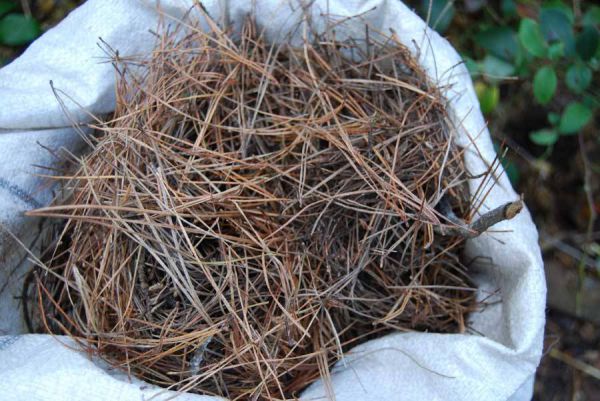

If it is not possible to combine these components at once, then at least a mixture of compost and peat / peat or coniferous litter / compost or coniferous litter should be used. Or just use one peat or compost. As a last resort, if you do not have such ingredients, then you can mulch at least with ordinary soil, which was taken from another place on your site.
Mulching paniculate and tree hydrangea need to be performed hilling method. The height of the mulch should be about 15 centimeters, while filling with a protective layer is necessary the center of the bush and the area around the bush at a distance of 30-40 centimeters in a radius.
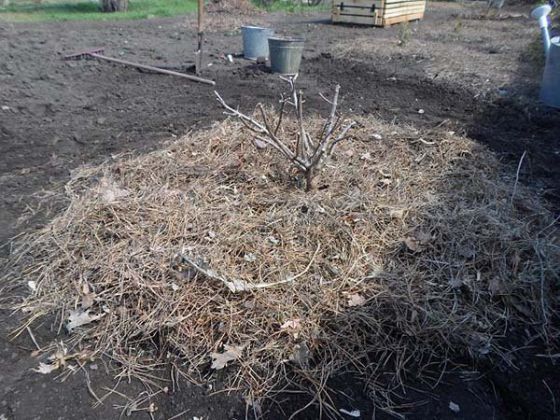

When is the best time to prune - in spring or autumn


Gardeners believe that the main advantage of autumn pruning is that it is impossible to be late with it, unlike spring haircuts. Summer residents do not always have the opportunity to visit their site in early spring. If the hydrangea wakes up from hibernation, and the juices begin to move, pruning can weaken it so much that flowering does not occur.
If you do this in the fall, then it is better to leave a stock on the shoots, and make a correction in March. The appropriate time to trim branches also depends on the varietal variety. Treelike and panicle hydrangeas can be pruned in autumn and spring, as well as carried out in stages. For a large-leaved representative of the family, only spring pruning is recommended.
Spring work with hydrangea
With the establishment of positive daytime air temperatures, overwintered hydrangeas can be gradually opened. Removing the shelter must be done in stages, giving the plant time to adapt to new living conditions, while providing it with sufficient ventilation. The final release of the plant from the insulating materials is carried out after the threat of recurrent frosts has passed, preferably on a cloudy, windless day.
After wintering, it is necessary to inspect the shrub, remove all frozen, damaged shoots. If pruning was not carried out in the fall to update the bush, it is done in March-April, guided by the same principles. In early spring, pruning of the bush can be done quite strongly, this will contribute to the formation of powerful shoots with large inflorescences. As a general rule, last year's shoots, on which the flowering of the shrub will mainly occur this year, are not cut off, with the exception of weak and damaged branches.
When to trim


Shoots should be shortened at a time when biological processes in plant tissues slow down and the shrub prepares for a state of complete dormancy. In hydrangea, this period begins after leaf fall. The most direct influence on the life cycle of the shrub is the weather, so the exact timing of pruning in each region will be different.
In the suburbs, the middle lane
The middle zone of Russia, including the Moscow region, is located in a zone with a temperate continental climate. Summers are warm here, and winters are snowy and moderately frosty. A slight subzero temperature is established, as a rule, at the beginning of November, at the same time snow cover falls on the ground.
Pruning hydrangeas is recommended just in this weather. It is permissible to do this a little earlier. The approximate timing of pruning hydrangeas in this climatic zone is in the second half of October and early November.
How to properly prune for beginners (diagram)
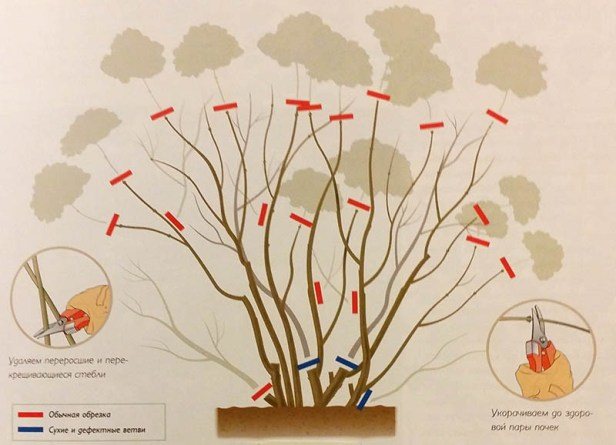

Inexperienced gardeners often lack the knowledge to care for their plants. However, you don't have to learn from your own mistakes. It is enough to study the information in advance to ensure that the plantings are properly cared for. Since pruning each type of hydrangea has its own characteristics, they must be taken into account. Consider how to properly prune each type of hydrangea in the fall.
Paniculata
In the case of paniculate hydrangea, don't be too zealous. Skeletal branches, those that grow from one point, are not touched. You only need to cut out incorrectly growing shoots - curves directed towards the inside of the bush. Faded panicles on the shoots of this year must be removed. If this is not done, young fragile twigs can break off under the weight of the snow.
The pruning of inflorescences is carried out together with a part of the shoot, leaving 3-4 lower buds on it. With this formation, the bush in the spring will look lush and neat at the same time. If the panicle hydrangea is already in need of rejuvenation, from the shoots that grow at one point, one healthy strong, directed outward, is left, and the remaining branches are cut off at the root. In the spring, extinct shoots are cut off and the bush is given its final shape.
Tree-like
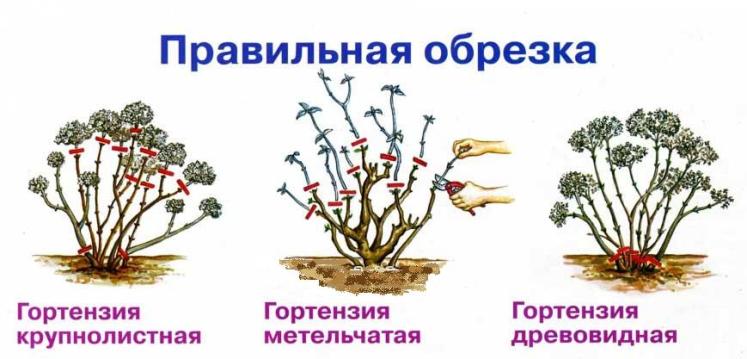

Young saplings of tree hydrangea do not touch the first 3-4 years. By breaking this rule, you can provoke the death of the bush. In a young bush, only faded inflorescences are removed. On the shoots, 3-4 pairs of buds must remain, from which new branches will subsequently grow, forming a lush crown.
In this form, the shrub takes cover and remains until spring. When the bush gets old, rejuvenating pruning is carried out. After it, stumps with a height of 10 cm should remain on the plant, which will give an impetus to the active growth of new branches.
Important! It is better to carry out anti-aging pruning with a gentle method, stretching for 2-3 years, otherwise the roots may not have enough nutrients and the plant will die.
Large-leaved


Large-leaved hydrangea blooms on the shoots of the second year, so it is important to preserve them during wintering. In the fall, only the cleaning of the bush is carried out, in which sick weak or old lower branches are removed. The upper branches hibernate under cover, in the spring they are examined and cut out by those that have suffered from frost. This type of hydrangea often sprouts from zero shoots, but there are almost no flower buds on the lower branches.
For this variety, it is recommended to prune the shoots immediately after flowering, so that the plant has time to grow new branches before the onset of winter. Thinning of the bush is carried out by cutting out the shoots directed inward. In order to rejuvenate large-leaved hydrangea every 3 years, part of the old shoots is cut to a height of 30-40 cm.
Before covering the plant, cut out old and diseased branches. Pruning also depends on the climate in which this hydrangea is grown. If summers are long and warm, deeper pruning can be done.
On a note! Radical cutting of large-leaved hydrangea is allowed in central Russia, in the Kuban and in the southern regions. In the Urals, Siberia and the Leningrad Region, only superficial pruning is permissible.
Why is it necessary to cover the hydrangea for the winter?
Hydrangeas are shrubs or small trees that grow in the wild mainly in Southeast Asia, Japan and China, and are also found in Latin America. It was from the Land of the Rising Sun that she was brought to Europe. It is interesting that the first varieties of it were quite winter hardy. But since then, about a hundred garden varieties have been created. Most of the newly developed varieties are thermophilic. Therefore, it is recommended to cover such plants for the winter, adhering to one of the methods described below.
Important! To understand what to do with them, you need to figure out how hydrangea winters. Flowers in most species bloom on the shoots of the current year. If frosts catch in the cold season, there is a risk that the shoots will freeze slightly. This does not always affect subsequent flowering, but it can play a role.


Hydrangea
Preparing hydrangea for winter includes the obligatory removal of faded inflorescences and pruning of shoots that have not yet become lignified, since the latter, most likely, will not survive the winter (especially when it comes to harsh climatic conditions, for example, in the Urals). It is believed that it is not necessary to trim the inflorescences, since this is more likely to save the buds located under them. But in fact, in regions with snowy winters, the left inflorescences increase the risk that shoots and branches will break under the weight of sediment accumulating on them. That is why they need to be removed - this is the only way to save the shrub as a whole.
As already mentioned, not all hydrangeas from those that are suitable for growing in the conditions of the Moscow region and the middle lane need shelter. Experts recommend covering only the large-leaved hydrangea and the Sargent hydrangea. It is believed that the hydrangea tree does not need this. But in fact, it all depends on age - young trees are not quite winter-hardy. In the first two years after planting, in order to preserve the plant, it will have to be additionally protected for the winter. And if we are talking about more severe climatic conditions, for example, in Siberia, then protection may be needed there even after the end of this period.
Care after pruning
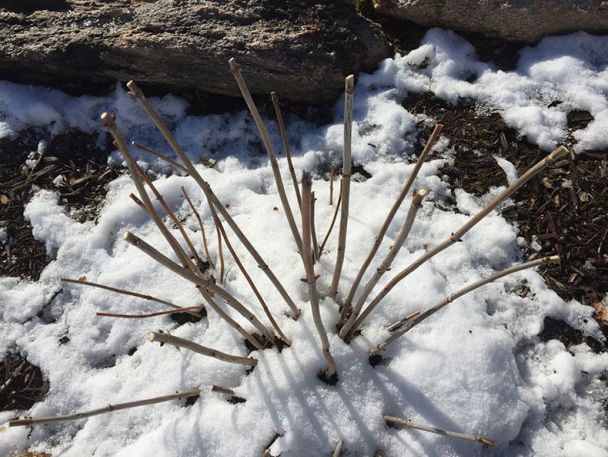

In a rainy fall, hydrangeas do not require watering. If the weather is dry, the soil under the plant must be moistened until the night air temperature approaches zero. The last feeding should be done in mid-September with phosphorus-potassium fertilizers. Its task is to nourish the roots that have become weakened after summer flowering. Fertilizers are applied in granular form, they are scattered in the near-stem circle of the hydrangea and slightly mixed with the ground.
After pruning, the hydrangea bush is covered for wintering. This is especially important for non-resistant varieties and hydrangea, which is grown in the northern regions. Shelter of the upper part of the plant should occur with the onset of the first frost. The soil is pre-mulched with sawdust or peat.
The standard method is to use a wooden box or agrofiber. The branches are bent to the ground, and then they are covered with a box or sprinkled with agrofibre. Spruce branches are additionally laid on top. Some summer residents use frame structures built around the bush to protect it. Dry foliage is poured inside the frame, and a layer of needles must be laid on top. The wireframe method is mainly used for covering large adult plants, the branches of which are difficult to bend down to the ground.
Features of preparing for the winter of different types of hydrangea
The preparation of a winter shelter depends on which variety and type of plant is grown on the site. The age and size of the bush are also taken into account. It is better to cover the aerial part of young plants for the first few winters, while for adult specimens it is enough to huddle and warm with snow.
Paniculata
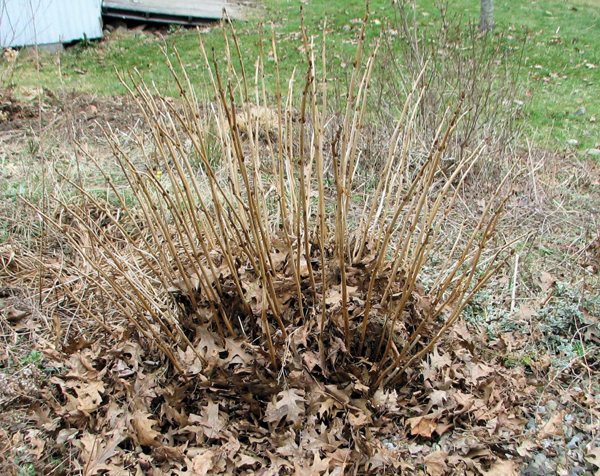

The peculiarity of the panicle hydrangea is that the developed buds are located in the areas of the branches from the base to the middle, therefore, the frosting of the tops of the shoots will not cause much harm to this plant. When constructing a shelter, it is necessary to take into account not only the temperature, but also the humidity of the air, the presence of winds. In a strong humid wind, hydrangea can die even in a slight frost.
The easiest way to cover the panicle hydrangea is hilling. For this, a mixture of dry garden soil and peat is used, which is poured on top of the bush. It is undesirable to use fallen leaves or sawdust for shelter; when wet, they easily rot, and in addition, they may contain pest larvae.
In cold regions, branches are additionally covered, having previously bent them to the ground. As a shelter, you can use roofing paper, spruce branches, burlap. Branches that are too long for convenience are best tied. Spunbond, lutrasil and other similar materials can be thrown on top of large specimens.
Large-leaved


Since the large-leaved hydrangea is the most thermophilic, it must be covered in advance, without waiting for frost. Before sheltering the shoots, the leaves must be cut off, leaving them only at the very top, protecting the apical buds. Then, for convenience, the bush is divided in half, and each part of the shoots is bent to the ground, after which it is pinned with thin arcs.
The middle of the bush should be covered with peat or coniferous forest floor. Lutrasil is thrown on top of the arcs in two layers and fixed near the ground with bricks or wooden beams. It is not recommended to use plastic wrap due to its airtightness. In spring, the shelter can be removed when the threat of frost has completely passed.
The best way to hide a large-leaved hydrangea for the winter: video
Tree-like
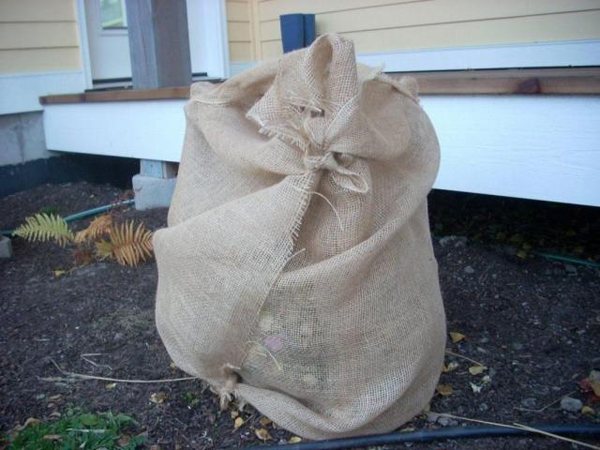

Treelike hydrangea is an unpretentious plant and perfectly recovers after winter. Its winter hardiness, like that of other species, increases with age, but it is better not to be lazy and make a preventive shelter for it. At the initial stage, the bush is spud up - this helps to insulate the roots.
Since the plants grow very large, they are not bent to the ground, but tied to a peg, forming a kind of cone. After that, the bush is covered with spruce branches on all sides. In cold regions, you can additionally use insulating material, it is fixed on the plant from above.



